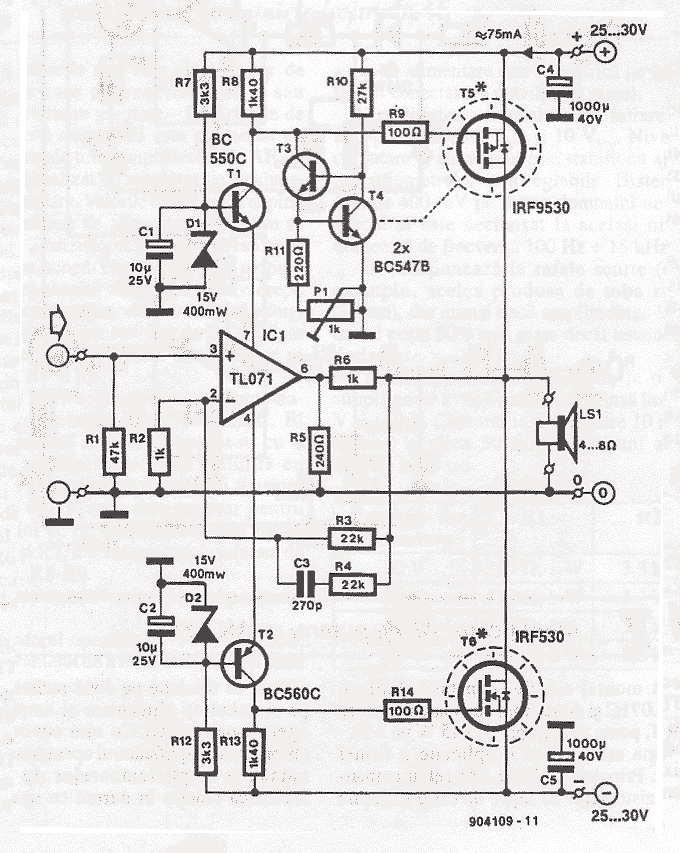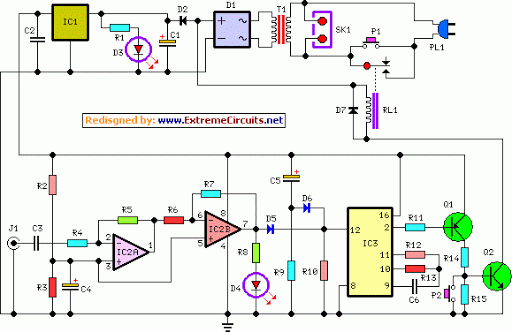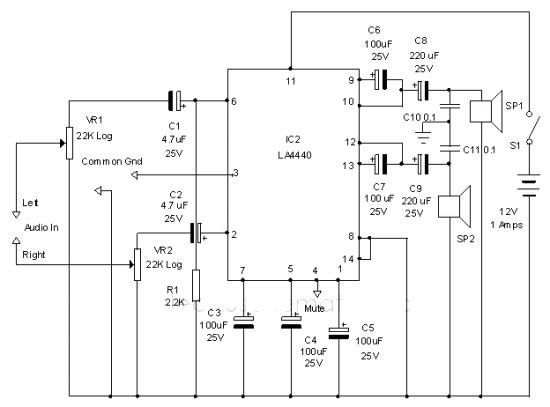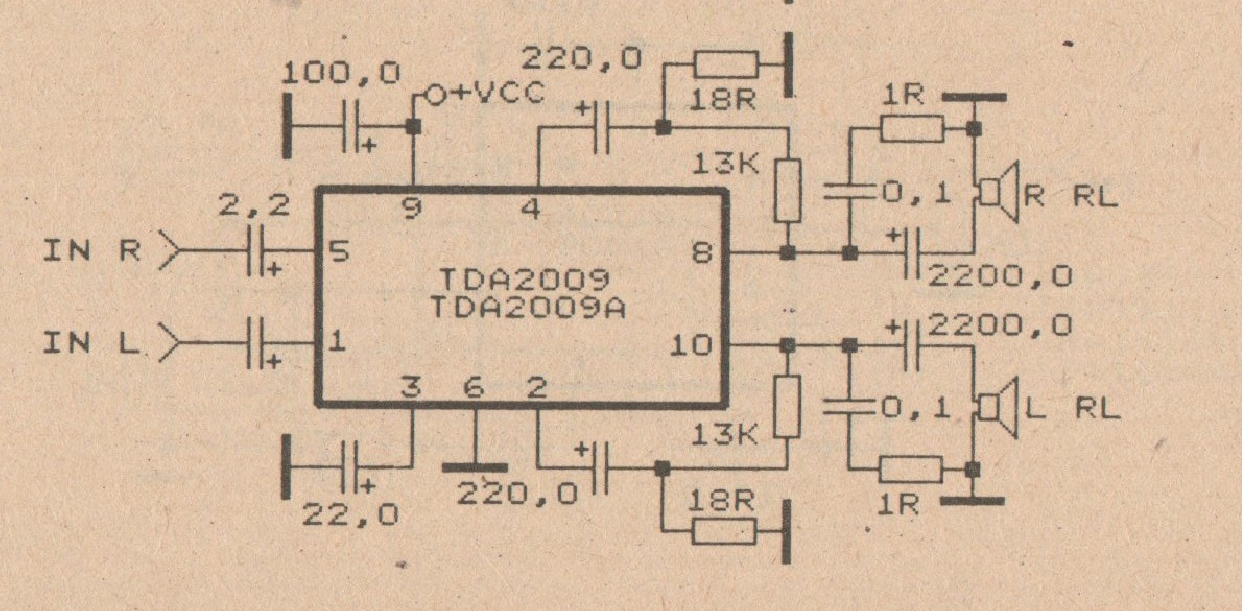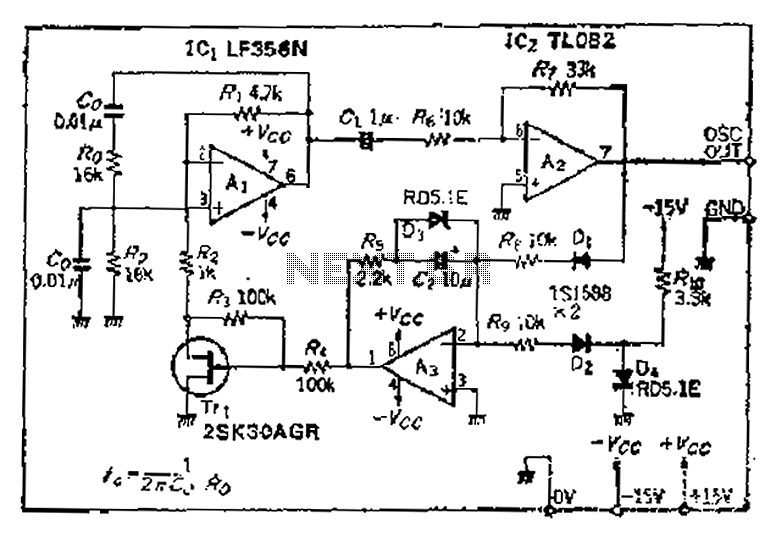
Guitar Amplifier
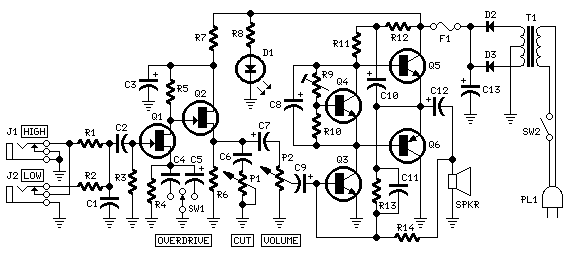
The objective of this design is to create a Combo amplifier that was popular during the 1960s and 1970s. It is particularly effective as a guitar amplifier but can also perform well with various electronic musical instruments or microphones. A 5W power output is a standard feature of these widely used devices, attributed to the common implementation of a class A single-tube output stage, similar to the Vox AC-4 model. The amplifier includes a two-FET preamplifier, two inputs with varying sensitivity levels, a treble-cut control, and an optional switch that enables overdrive or enhanced treble. In instances where Darlington transistors are utilized as output devices, it is crucial for the sensing transistor (Q4) to maintain close thermal contact with the output transistors. Consequently, a TO-126 case transistor type was selected for easy mounting on the heatsink, positioned in close proximity to the output pair. The volume control should initially be set to the minimum, and Trimmer R9 should be adjusted to its minimum resistance. Upon powering the circuit, R9 should be calibrated to achieve a current draw of approximately 25 to 30 mA.
The Combo amplifier design features a classic architecture that integrates both preamplification and power amplification stages within a single unit, making it versatile for various audio applications. The two-FET preamplifier stage is designed to provide a high input impedance, allowing it to interface effectively with different musical instruments or microphones without significant signal loss. The inclusion of two inputs with different sensitivity settings enables users to connect instruments with varying output levels, enhancing the amplifier's usability.
The treble-cut control is an essential feature that allows for tonal shaping, enabling users to modify the high-frequency response to suit their preferences or the acoustic characteristics of the instrument being amplified. The optional switch for overdrive or treble enhancement introduces additional versatility, allowing the user to achieve a range of sounds from clean tones to more aggressive, distorted sounds typical in rock music.
The design's attention to thermal management is critical, particularly when utilizing Darlington transistors, which can generate significant heat during operation. The choice of a TO-126 case transistor ensures that the sensing transistor (Q4) is thermally coupled to the output transistors, allowing for accurate temperature monitoring and preventing thermal runaway conditions.
In terms of operational setup, the initial configuration of setting the volume control and Trimmer R9 to their minimum values is crucial for ensuring a safe power-on sequence. This precaution helps to avoid sudden loud outputs that could damage speakers or lead to an unpleasant user experience. After powering the circuit, adjusting R9 to achieve a current draw of 25 to 30 mA ensures that the amplifier operates within its designed parameters, promoting longevity and reliable performance. Overall, this Combo amplifier design encapsulates the essence of vintage amplification while incorporating modern design considerations for thermal management and user flexibility.The aim of this design is to reproduce a Combo amplifier of the type very common in the `sixties and the `seventies of the past century. It is well suited as a guitar amplifier but it will do a good job with any kind of electronic musical instrument or microphone.
5W power output was a common feature of these widespread devices due to the general adoption of a class A single-tube output stage (see the Vox AC-4 model). It also features a two-FET preamplifier, two inputs with different sensitivity, a treble-cut control and an optional switch allowing overdrive or powerful treble-enhancement. * In all cases where Darlington transistors are used as the output devices it is essential that the sensing transistor (Q4) should be in as close thermal contact with the output transistors as possible.
Therefore a TO126-case transistor type was chosen for easy bolting on the heatsink, very close to the output pair. * Set the volume control to the minimum and Trimmer R9 to its minimum resistance. * Power-on the circuit and adjust R9 to read a current drawing of about 25 to 30mA. 🔗 External reference
The Combo amplifier design features a classic architecture that integrates both preamplification and power amplification stages within a single unit, making it versatile for various audio applications. The two-FET preamplifier stage is designed to provide a high input impedance, allowing it to interface effectively with different musical instruments or microphones without significant signal loss. The inclusion of two inputs with different sensitivity settings enables users to connect instruments with varying output levels, enhancing the amplifier's usability.
The treble-cut control is an essential feature that allows for tonal shaping, enabling users to modify the high-frequency response to suit their preferences or the acoustic characteristics of the instrument being amplified. The optional switch for overdrive or treble enhancement introduces additional versatility, allowing the user to achieve a range of sounds from clean tones to more aggressive, distorted sounds typical in rock music.
The design's attention to thermal management is critical, particularly when utilizing Darlington transistors, which can generate significant heat during operation. The choice of a TO-126 case transistor ensures that the sensing transistor (Q4) is thermally coupled to the output transistors, allowing for accurate temperature monitoring and preventing thermal runaway conditions.
In terms of operational setup, the initial configuration of setting the volume control and Trimmer R9 to their minimum values is crucial for ensuring a safe power-on sequence. This precaution helps to avoid sudden loud outputs that could damage speakers or lead to an unpleasant user experience. After powering the circuit, adjusting R9 to achieve a current draw of 25 to 30 mA ensures that the amplifier operates within its designed parameters, promoting longevity and reliable performance. Overall, this Combo amplifier design encapsulates the essence of vintage amplification while incorporating modern design considerations for thermal management and user flexibility.The aim of this design is to reproduce a Combo amplifier of the type very common in the `sixties and the `seventies of the past century. It is well suited as a guitar amplifier but it will do a good job with any kind of electronic musical instrument or microphone.
5W power output was a common feature of these widespread devices due to the general adoption of a class A single-tube output stage (see the Vox AC-4 model). It also features a two-FET preamplifier, two inputs with different sensitivity, a treble-cut control and an optional switch allowing overdrive or powerful treble-enhancement. * In all cases where Darlington transistors are used as the output devices it is essential that the sensing transistor (Q4) should be in as close thermal contact with the output transistors as possible.
Therefore a TO126-case transistor type was chosen for easy bolting on the heatsink, very close to the output pair. * Set the volume control to the minimum and Trimmer R9 to its minimum resistance. * Power-on the circuit and adjust R9 to read a current drawing of about 25 to 30mA. 🔗 External reference
